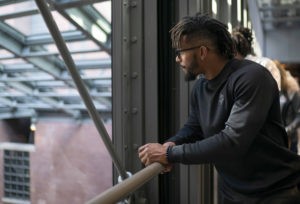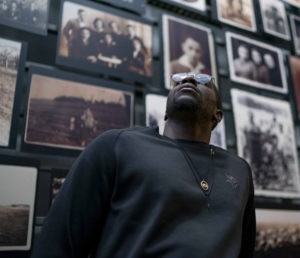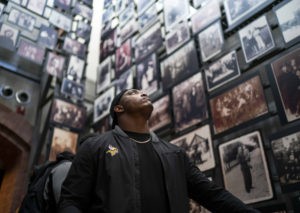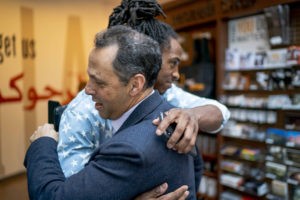So when he took four of his players, some former players, and team staffers to Washington, D.C., to the Smithsonian National Museum of African-American History and Culture and the United States Holocaust Memorial Museum, it was more than a way to experience history: It was to understand where each comes from.
“We wanted to do that trip, and a lot of the other social justice initiatives we’re doing, to build a better understanding and build empathy for each other’s backgrounds, and in effect make a positive impact on the future,” said Wilf. “From ownership’s perspective, we really want to be a model in the community. The Vikings are about teamwork and giving back. I think those are the themes that are advanced by the visit we had in Washington.”
Ameer Abdullah was a history major at the University of Nebraska, and while he read about the Holocaust, it took the trip to really understand the plight of the Wilf family nearly 65 years ago. Wilf’s parents, Joseph and Elizabeth, were from Poland, and both survived the Holocaust. Joseph, who was the first North American chair of March of the Living, passed away in 2016.
“His testimony was crazy because sometimes you read history and it can be so distant from you personally that you can’t really put into perspective how different life could be for him,” Abdullah said. “It was just a dark and terrible past. As much as some people want to forget, we should never forget, because you never know when that’s going to resurface in today’s aspect. So just making sure that you’re aware and you’re sensitive to those topics, understanding what the Jewish community has gone through.”

Vikings’ running back Ameer Abdullah. (Photo Courtesy the Minnesota Vikings)
Wilf thinks that his family’s experience as Holocaust survivors helped him in building empathy in relating to his players.
“Everyone has different backgrounds. The background of my family and coming from a place of intolerance and hate and what that led to, I think, forces us to be sensitive to things that we hear,” Wilf said. “As a corollary, I think the players have come through different experiences that have shaped their views, where they might have either experienced or seen or heard about injustice in their own communities.
“So I think from that standpoint, I wouldn’t call it credibility; I just think it’s the realities we’ve all experienced, and we share our life experiences. And by hearing each other and talking things out, together we can hopefully – through teamwork and collaboration with our coaches, or players or organization – make a difference with social justice in the community.”
Anthony Harris, a safety in his fifth year with the Vikings, has frequently been involved in community service activities since he joined the Vikings as an undrafted free agent in 2015. He said the trip was a great opportunity to give back and work with the youth, but also to touch base with important history.
“We can stay familiar with where we’ve been, where we’re trying to go as a country, and how we can learn from the past,” he said.
Having owners like the Wilfs who are willing to create a relationship with their players is important to Wright.
“I think that is a great opportunity for both parties; the players to be able to bring the Wilfs on board with some of the foundations and projects that they want to do, as well as the Wilfs sharing what’s important to them, and then everybody kind of coming together,” he said.
The Wilfs have committed $250,000 both this year and last year towards social justice initiatives, but they are looking for the players’ input. Some of the areas that they have landed on include helping at-risk schools, juvenile detention centers, and police departments. Joining the players at the African-American history museum were 50 Minneapolis high school students in the Project Success program.

Stephen Weatherly looks up at the Tower of Faces at the Holocaust Museum. (Photo Courtesy the Minnesota Vikings).
“Those are all things that tap into some of the things that players were concerned about, what they saw growing up and the things they see in their communities or in their families that are important to them,” Wilf said. “So we want to do things in those areas that matter to us, but also as importantly, that matters to the players, and to the community.”
Back to the days of Jackie Robinson breaking baseball’s color barrier to Tommie Smith and John Carlos protesting at the 1968 Olympics, sports have been an agent for social change. Wilf is embracing that.
“It is a platform where social change can happen and be initiated, and I think in some of these areas, we’ve made some progress,” he said. “In the law enforcement area. I know that was a concern of some of our team, and we had developed good relationships with the Minneapolis and St. Paul police and fire departments, spending days with them and with first responders. We’re all for positive social change.”
Taking It All In
Weatherly was part of a trip to Germany as part of the Fulton County Youth Commission when he was in high school. He saw many things, including visiting a concentration camp. So while the Holocaust isn’t new to him, the way it was presented at the museum stuck with him.
“The Holocaust Museum does a great job of taking things that you’ve read all throughout grade school, and even in college, and really

Fullback C.J. Ham takes in the Tower of Faces at the Holocaust Museum (Photo Courtesy the Minnesota Vikings).
bringing it to life,” he said. “And so there’s one part where you see shoes. You see them and you hear the numbers, you hear about the devastation? And just the millions of lives lost. And when you see the shoes that hits you.
“In many different ways, it takes time to show you the devastation. It really brings it so it hits home, so you have a better grasp of what actually happened.”
While Weatherly and Abdullah both had a lot of knowledge on the topics of the two museums, Weatherly knew the high school kids didn’t.
“Some of those kids have never seen anything close to the Holocaust Museum,” he said. “So for them to go there and actually take that and learn. And what was amazing, the way they set up – and they did this on purpose – was seeing the trials and tribulations of both groups and the things they went through.”
For Harris – and the teens – getting to have an experience like this trip helped create a personal connection that helped make learning about the topic all the more relevant.
“It’s different when you learn about it in the classroom; you have to try to find a connection to really be absorbed and taken in by whatever information or topic you’re talking about,” he said. “So going there being a little bit more mature, getting to see the visuals and have a little bit of a hands-on (opportunities), I think is more of an impact than learning in a classroom setting.”
Finding Common Ground
Abdullah, a fifth-year running back, competes hard on the field. Off the field, however, he sees no reason that Jews and African-Americans should compete about who’s had it tougher.
“It’s a strange dynamic that we live in. Two peoples who go through two traumatizing histories and a lot of people want to compare those histories, which is not the point,” he said. “The point is to learn from those histories and to better the people around you after those experiences. A lot of times we’re very primitive in our thoughts and we want to compete all the time for no reason.”
This from an athlete whose livelihood is based on competing.
“You know when to turn it on and turn it off,” he said. “The situation, when we’re speaking socially, is about what’s right for the people, not who had it worse. You hear that a lot and it definitely bothers me personally.”
Said Weatherly: “When you go to these museums, you start to see similarities, and when you see similarities between groups, that’s when you truly start to move forward as a nation, so that’s important. With knowledge, comes progression.”
C.J. Ham, a third-year fullback from Augustana College in South Dakota, said both Jews and African-Americans haven’t let their past define them.

Safety Anthony Harris and Vikings owner Mark Wilf after walking through the Holocaust Museum (Photo Courtesy the Minnesota Vikings)
“Even though Jews and African-Americans had every excuse to just back down and let it happen, they both found a way to fight and use it for the good and not let it define who they are,” he said.
Ham grew up in Duluth – the lone northerner of the Vikings players that went on the trip. He saw the racism growing up, and he still sees it today being half of a bi-racial couple with his wife, Stephanie.
“Racism is everywhere in all different shapes and forms, no matter where you live north or south,” he said. “I still experienced it in Duluth being one of the only African-Americans in my class. Those lessons I took from that is not to let it define me. Even though I might be viewed as something without them even knowing who I am, [I have to] just make sure I’m going out there and doing what I can to be judged upon how I am as a man not how I am because of the color of my skin.”
 This piece received 2nd Place in the category Award for Excellence in Writing About Sports from the American Jewish Press Association’s 39th annual Simon Rockower Awards for Excellence in Jewish Journalism
This piece received 2nd Place in the category Award for Excellence in Writing About Sports from the American Jewish Press Association’s 39th annual Simon Rockower Awards for Excellence in Jewish Journalism




More people should see the Holacaust museum. Then possibly understand, that they aren’t the only nationality or religious group who have suffered, been ostracized, tortured and killed. I enjoyed reading and admired what the Wilf’s have done to enlighten people.
My friend who is Black thinks her family and race are the only ones who have suffered and were killed. Unfortunately she has never understood what I have explained to her about the Holocaust. Some people are narrow minded and may never listen and comprehend. Sad.
Great article! Yes there should be no competition or comparing of other peoples’ suffering but learning from it & from each other. Native Americans, black & brown skinned, African American,, Jewish along with other minority cultures all had & have their share of suffering. Please let’s help lift each other up not down! And be more compassionate and understanding of each other. This story is a great beginning! A Well deserved award for this article! Thank you for writing it!